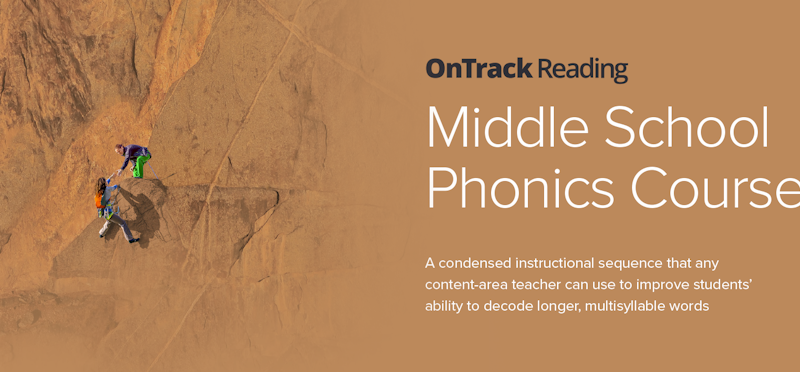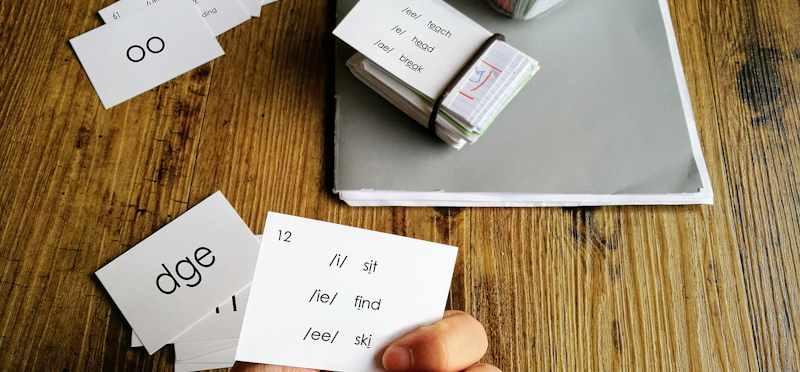This article summarizes the method used to show a child how to break a longer unfamiliar word into separate chunks so that the word can be read chunk by chunk. He is then taught to blend the chunks together, testing and retesting sounds until he reaches a spoken word that he recognizes. This is not the curriculum; it's an overview of the decoding method taught when the curriculum is used.
The OnTrack Reading Multisyllable Method utilizes a Main Rule and Three Exceptions to the Main Rule.
Middle School Phonics Course - Digital Download
The Main Rule:
Stop each chunk after the vowel sound and try the First Vowel Sound
Examples:
- talent (ta lent) - Decoded on the first pass
- limit (li mit) - Decoded on the first pass
- circus (cir cus) - Decoded on the first pass
- resting (re sting) - This one bothers adults, but will be decoded on first pass
- circumference (cir cum fer ence) - Decoded on the first pass
All the examples decode accurately on the first pass because only First Vowel Sounds were found in each word.
Examples of having to test the vowel sounds and getting it on the second pass:
- paper (pa per) - Sounds like papper on first attempt, but gets paper when the Second Vowel Sound of a is then attempted.
- table (ta ble) - Goes from tabble on first pass to table on second.
- crisis (cri sis) - Goes from crissis on first pass to crisis on second.
- recent (re cent) - Goes from ressent on first pass to recent on second.
- wasting (wa sting) - Decoded on the second pass
The First Exception
Add a doubled consonant to the chunk
Reason: Doubled consonants nearly always indicate the pronunciation of the preceding vowel sound as a First Vowel Sound, i.e., as a short vowel sound in most cases.
Examples (showing adjustment of first chunk when second chunk is examined):
- dinner (di nner, then dinn er) - Decoded on first pass, and not confused with diner
- mopping (mo pping, then mopp ing) - Decoded, and not confused with moping
- bitter (bi tter, then bitt er) - Decoded, and not confused with biter
- stripping (stri pping, then stripp ing) - Decoded, and not confused with striping
The Second Exception
Add a Marker to the chunk
Reason: The Markers are ck, tch, x, and dge/dg. Markers nearly always "mark" the preceding vowel sound as a First Vowel Sound, i.e., as a short vowel sound in most cases. (dge appears in words of one-syllable like badge and ledge.)
Examples (showing adjustment of the first chunk when the second chunk is examined):
- sticker (sti cker, then stick er) - Decoded on first pass
- stretcher (stre tcher, then stretch er) - Decoded
- toxic (to xic, then tox ic) - Decoded
- badger (ba dger, then badg er) - Decoded
The Third Exception
Add a consonant if the next chunk is "Hard to say"
Reason: If the beginning of a chunk is hard to pronounce, it has an illegal starting blend that, in kid's language, makes it "Hard to say." Moving it to the preceding chunk almost always locks in a short vowel sound in that chunk by creating a closed syllable.
Examples:
- jumping (ju mping, then jum ping) - Decoded on first pass
- insect (i nsect, then in sect) - Decoded
- instructed (i nstru, then in stru cted, then in struc ted) - Decoded
- constantly (co nsta, then con sta ntly, then con stan tly, then con stant ly) - Decoded on the first pass (after applying Third Exception three times, including twice in one chunk)
The Next Step in the Process of Decoding
After stepping through words in the process described above, chunking them and moving doubled consonants, Markers, and the start of illegal blends to previous chunks, the word is pronounced using First Vowel Sounds (which are usually, but not always, just the traditional short vowel sound.)
Then the student tries to match what he has said to a word in his oral vocabulary. If he can't, he is shown how to adjust vowel sounds systematically in the chunks in a second attempt to match the word to one he has heard before. However, the chunks that have had letters added to them under one of the Exceptions are nearly always already being correctly pronounced. Therefore, the student only needs to test the remaining chunks. This reduces the time required to do the testing of the vowel sounds.
Most words can be decoded, or get close enough to recognize, in three or less attempts. Once decoded in this manner, the words tend to be easier to decode the next time they appear, which eventually leads to their accurate and fluent reading in the future once new neural pathways have formed.
Why This Method Is a Natural Process
If you examine each of the Three Exceptions, you will see that they all remove letters and digraphs from the beginnings of chunks that typically don't begin words. English words don't begin with doubled consonants, but do end with them (fill, miss, buzz). They also don't begin with Markers, but end with them (check, hatch, box, badge). And, by definition, they don't begin with illegal blends like nt, lp, mp and lt.
That makes it easy for a child to recognize them and move them; they just look strange at the beginning of a chunk. This is a happenstance in that it wasn't planned, but it makes it easier for a young child to become accustomed to using the method.
A Key Benefit to Using This Method
Another key benefit to teaching an older child this method of decoding longer words is that it has them continually focussing on the spellings of the vowel sounds. One of the more confusing features of English spellings is that the same vowel sound can usually be spelled several different ways. Another source of confusion is that the same vowel spelling can represent as many as three or four different sounds.
This decoding method has them always looking for vowel spellings on the first pass through a word, then systematically testing the various sounds associated with those spellings if they don't get the word on the first pass. Instead of guessing at the middle and ending of a word, they begin examining each chunk and analyzing the sounds within them.
I worked with nearly two hundred struggling readers for a decade, and this multisyllable decoding method was particularly effective in getting them to decide, on their own, to drop their often long-established habit of guessing at unfamiliar words. They'd finally found a strategy they trusted more than taking a guess. It works, and you should ask yourself if your older students would benefit from learning it.




